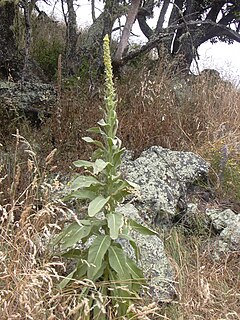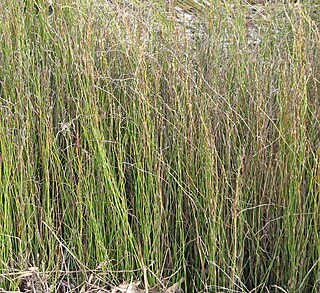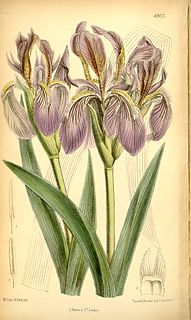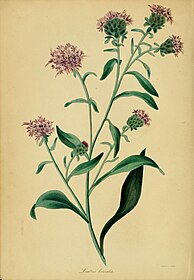
In cell biology, the cytoplasm is all of the material within a cell, enclosed by the cell membrane, except for the cell nucleus. The material inside the nucleus and contained within the nuclear membrane is termed the nucleoplasm. The main components of the cytoplasm are cytosol – a gel-like substance, the organelles – the cell's internal sub-structures, and various cytoplasmic inclusions. The cytoplasm is about 80% water and usually colorless.

Oregano is a flowering plant in the mint family (Lamiaceae). It is native to temperate Western and Southwestern Eurasia and the Mediterranean region.

Organisms of many species are specialized into male and female varieties, each known as a sex. Sexual reproduction involves the combining and mixing of genetic traits: specialized cells known as gametes combine to form offspring that inherit traits from each parent. The gametes produced by an organism define its sex: males produce small gametes while females produce large gametes. Individual organisms which produce both male and female gametes are termed hermaphroditic. Gametes can be identical in form and function, but, in many cases, an asymmetry has evolved such that two different types of gametes (heterogametes) exist.

Verbascum thapsus, the great mullein or common mullein, is a species of mullein native to Europe, northern Africa, and Asia, and introduced in the Americas and Australia.

Anthemis is a genus of aromatic flowering plants in the family Asteraceae, closely related to Chamaemelum, and like that genus, known by the common name chamomile; some species are also called dog-fennel or mayweed. Anthemis are native to the Mediterranean region and southwest Asia east to Iran. A number of species have also become naturalized in the United Kingdom and other parts of the world.
Maesobotrya is a genus of flowering plant belonging to the family Phyllanthaceae first described as a genus in 1879. It is native to sub-Saharan Africa.

Acacia acanthoclada, commonly known as harrow wattle, is a low, divaricate, highly branched and spinescent shrub that is endemic to Australia.
Micrococca scariosa is a species of plant in the Euphorbiaceae family. It is found in Kenya and Tanzania.
This glossary of botanical terms is a list of terms relevant to botany and plants in general. Terms of plant morphology are included here as well as at the related Glossary of plant morphology and Glossary of leaf morphology. See also List of Latin and Greek words commonly used in systematic names. You can help by adding illustrations that assist an understanding of the terms.

Lepyrodia is a plant genus in the family Restionaceae, described as a genus in 1810.

Oxychloris is a genus of Australian plants in the grass family. The only known species is Oxychloris scariosa.

Ursinia is a genus of African plants in the chamomile tribe within the daisy family.
Leptocarpus is a genus of dioeceous rush-like perennial plants described as a genus in 1810.
Meeboldina is a plant genus in the family Restionaceae, described as a genus in 1943.

Iris glaucescens is a species in the genus Iris, it is also in the subgenus of Iris. It is a rhizomatous perennial, from Asia, Russia, Kazakhstan, Mongolia and China. It has blue-grey sickle-shaped leaves, slender stem, and spring flowers in blue-violet, pale violet, lilac-purple, to deep purple, to light bluish, and almost white shades.It is rarely cultivated as an ornamental plant in temperate regions. It was merged with another similar iris in the region, and became a synonym of Iris scariosa, before being divided into two separate species again. Although some sources still call it a synonym of Iris scariosa.

Iris scariosa is a species in the genus Iris, it is also in the subgenus of Iris. It is a rhizomatous perennial, from the mountainsides of Russia, Kazakhstan, Mongolia and China. It has sword-like, or sickle shaped, blue green or grey-green leaves, a short flowering stem, 3 or 4 membranous or semi-transparent flower bud leaves, 2 violet, reddish violet, lilac, blue-purple, or blue flowers in late spring, with yellow or white beards. It is cultivated as an ornamental plant in temperate regions. It was merged with another similar iris in the region, and Iris glaucescens became a synonym of Iris scariosa, before being divided into two separate species again. Although some sources still call it the main species, despite a slight colour difference.
Iris timofejewii is a species of flowering plant in the genus Iris, and also in the subgenus Iris. It is a rhizomatous perennial, from the mountain slopes of the Caucasus and Dagestan. It has narrow, evergreen, falcate (sickle-shaped), grey-green (glaucous) leaves, and a short flowering stem just taller than the leaves. Each stem has 1–2 flowers in shades of violet, with white beards that have purple tips. It is cultivated as an ornamental plant in temperate regions.

Liatris novae-angliae, commonly known as the New England blazing-star, is a species of flowering plant in the aster family, Asteraceae.
Triodia scariosa, commonly known as porcupine grass, is a species of grass native to arid southern Australia.















